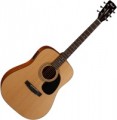The number of strings used in the instrument.
The traditional option for classical and acoustic guitars (see "Type") is
6 strings. However, in such instruments and in other varieties you can also find other options:
4,
5,
7,
8 and even
12 strings. Here is a more detailed description of each of them:
— 4. Traditional number of strings for ukuleles and acoustic bass guitars (see “Type”); In both cases, a larger number of strings can be used, but 4 is considered a “classic of the genre”.
— 5. Option found in certain models of acoustic bass guitars. 4 classic bass strings in such instruments are complemented by a fifth, expanding the range of the instrument upwards. The downside is the increased cost of such basses, despite the fact that an extended range is not required so often for an acoustic instrument. Therefore, this option has not gained much popularity.
— 6. The most popular number of strings in modern guitars of “regular” varieties (acoustic, classical, electro-acoustic - see “Type”). When talking about such a guitar, by default they mean a six-string instrument. The standard tuning of such models is EADGBE (note that the traditional tuning of bass guitars and some varieties of ukuleles is also based on it).
There are
...also other, much rarer varieties of six-string instruments - the guitarele (see “Form (type)”), as well as the ukulele with a pair of double strings (usually the second and third).
— 7. Most of the models in this category are so-called “Russian” seven-string guitars (another name is “gypsy”). They differ from the popular six-string ones not only in the number of strings, but also in the tuning - DGBDGBD. As for the sound, it is generally similar, although professional musicians and musicologists consider the seven-string guitar to be a “smoother” and richer instrument in terms of sound. Such guitars were popular mainly until the end of the twentieth century - in particular, it was the seven strings that were used by such famous bards as Vladimir Vysotsky and Bulat Okudzhava. However, in our time, this variety has fallen out of mass use.
Another, even rarer in our area, type of seven-string guitar is the “Brazilian”. This instrument uses the BEADGBE tuning - that is, essentially the standard tuning of a six-string guitar with an additional bass string in tone B (electric guitars with 7 strings are also tuned as standard ).
— 12. Modification of a six-string guitar, which uses 6 pairs of strings. The strings within each pair are at a minimum distance from each other and, as a rule, are tuned in unison or an octave - that is, roughly speaking, they sound together (however, professional guitarists also use more specific tuning options). This instrument is used mainly for rhythmic accompaniment: paired strings are inconvenient for solo parts, but they give a very rich sound in chords and are excellent for accompaniment. We also note that within one pair you can use strings from different materials, which gives the sound a special coloring.
— 8. Instruments with this number of strings are mainly ukuleles, similar in design to the 12-string guitars described above: instead of the traditional 4 strings, they have 4 pairs of strings. The specifics of such instruments are similar - they have a richer and more intense sound when accompanied, but are poorly suited for solo parts.
Another, much rarer version of 8 strings is six-string guitars, where the middle strings (third and fourth) are made paired. This is a compromise between the 6- and 12-string designs, providing a richer sound without significantly complicating the design and increasing its price.
